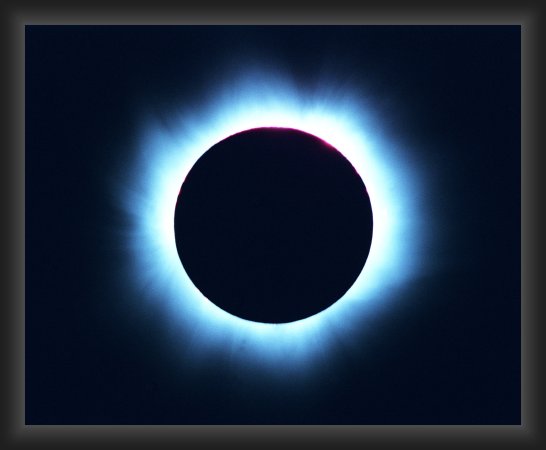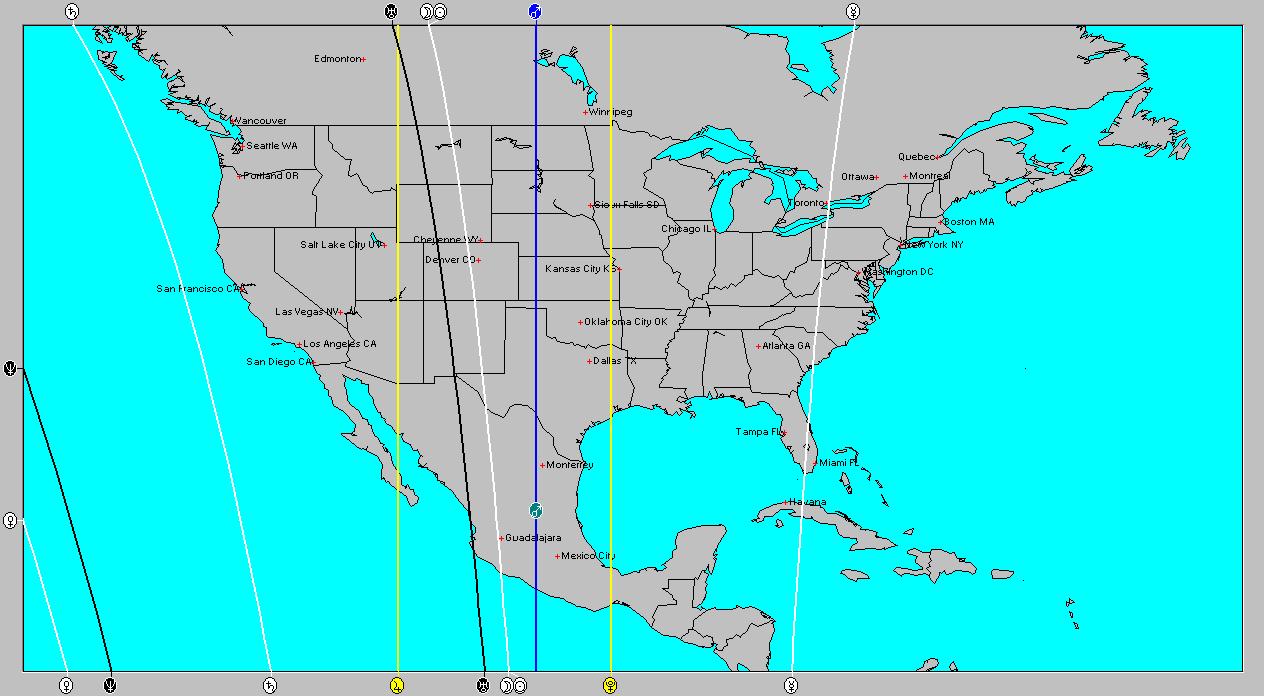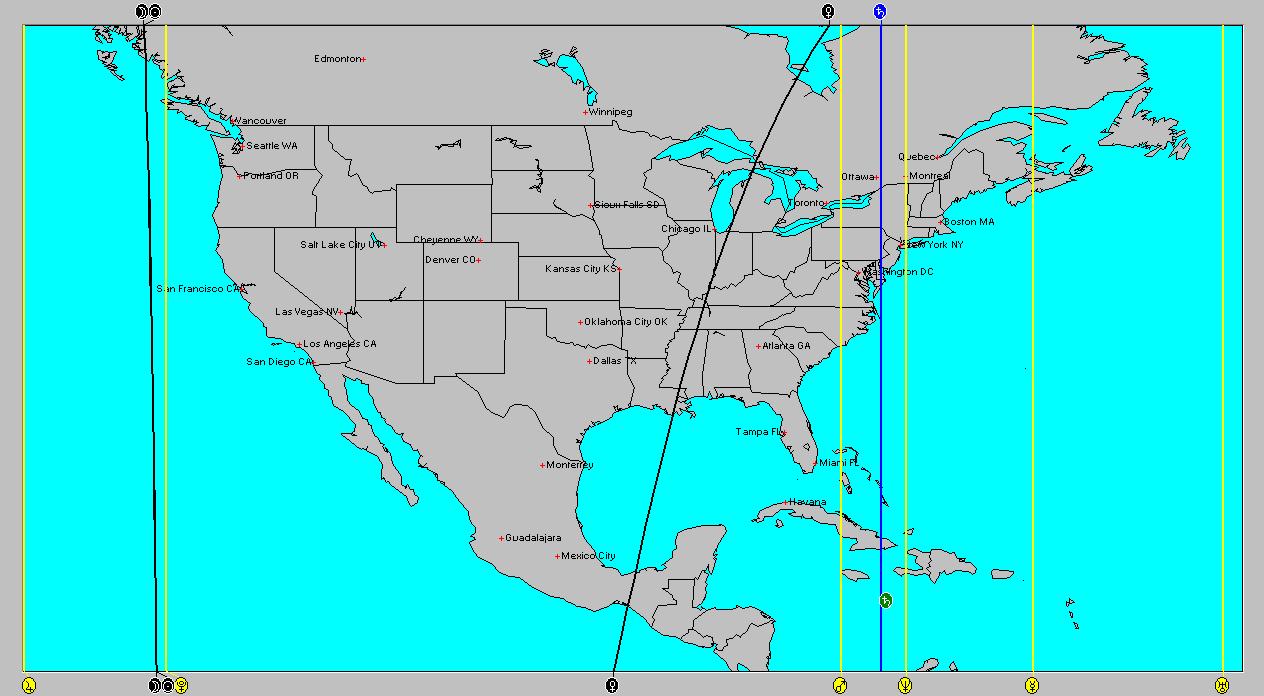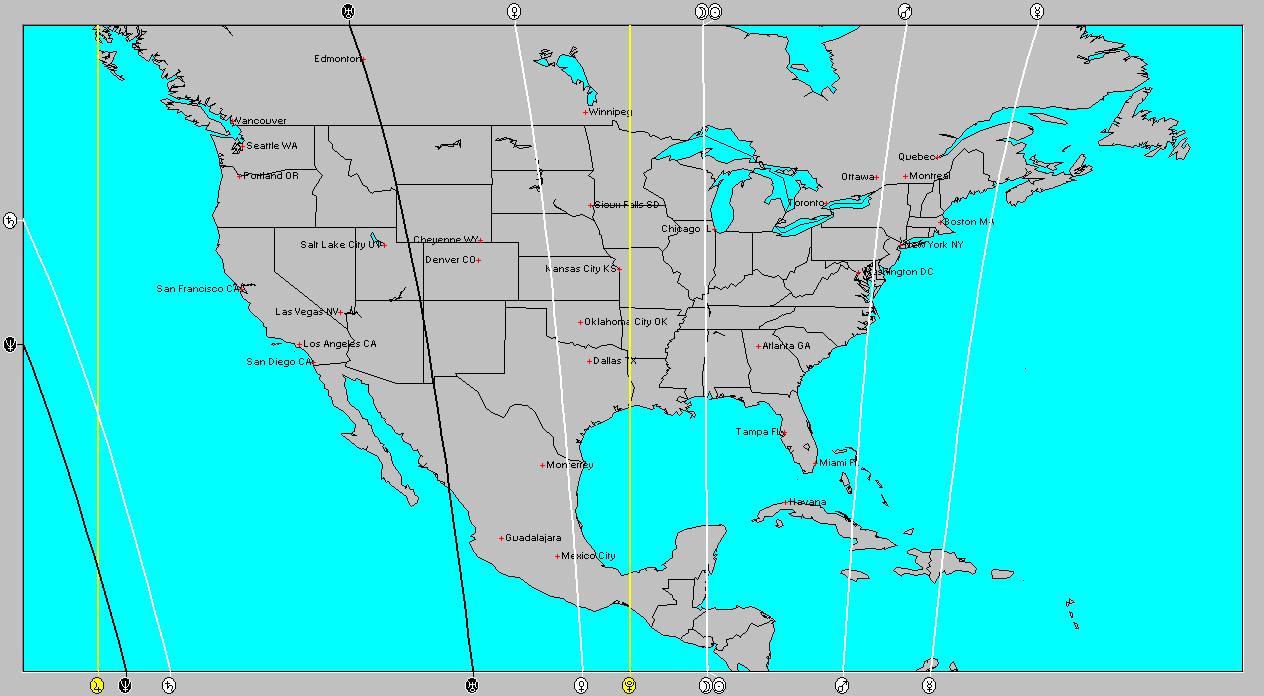 The Solar Eclipse of August 1, 2008 will receive a series of aspects this fall that are considered as activation stimuli to the energies represented by the eclipse. The Sun and Moon ascended across the Northeast U.S. at the time of eclipse. Following are some of the dates when the eclipse will be spurred into action and some of the most likely weather scenarios that will result.
The Solar Eclipse of August 1, 2008 will receive a series of aspects this fall that are considered as activation stimuli to the energies represented by the eclipse. The Sun and Moon ascended across the Northeast U.S. at the time of eclipse. Following are some of the dates when the eclipse will be spurred into action and some of the most likely weather scenarios that will result. September 30-Oct 3, 2008
September 30-Oct 3, 2008Transit Venus will square the eclipse degree on October 1st. While the planets from Mars on out to Pluto are usually considered the most potent triggers, this square from Venus may result in some weather activity. The area south of Puerto Rico, in and around 66 west longitude and 14 north latitude is likely to exhibit atmospheric instability at this time. This may take the form of a tropical wave or depression that could soak the Isla del Encanto (Puerto Rico). Since Venus is parallel Neptune at this time, eastern Canada (around 66 west/49 north) may also be subject to heavy rain. The Northeast U.S. will also see an increase in moisture leading to precipitation.
October 16-19, 2008
Mars squares the eclipse degree on the 17th as it parallels Neptune. Mars is more energetic in its influence. The same areas mentioned above i.e. the area south of Puerto Rico, eastern Canada, and the Northeast U.S. will experience strong weather patterns involving rising masses of very moist warm air, and semi-tropical to tropical low pressure systems. Hence, Puerto Rico may catch some strong rains as a potential tropical system develops south of the island. Strong low pressure systems resulting in heavy downpours and isolated flash floods may result over the Northeast U.S. and eastern Canada.
Nov 1-4, 2008
The Sun now squares the eclipse degree as it parallels Neptune. Once again, the area south of Puerto Rico bears watching for tropical storm genesis. The Northeast U.S. will be a target for severe storms as well as eastern Canada. One more area that should show an atmospheric reaction is area along the 114th line of west longitude. This takes in the central Baja California, the U.S. desert Southwest on into Idaho and Montana.
Severe weather is indicated over this area since it coincides with Saturn’s opposition to Uranus. This would suggest a possible tropical storm or hurricane strike over the Baja area or a robust cold front lowering temperatures and producing strong storms throughout the western U.S.
 The Solar Eclipse of Sept 11, 2007
The Solar Eclipse of Sept 11, 2007October 28-31, 2008
This Solar Eclipse is activated by Saturn’s conjunction on October 29th. The Sun and Moon ascended over the Rockies at the time. Saturn’s influence should trigger cold, and damp weather over the region. This may take the form of a major low pressure system. Since transit Mars is also sextile tranist Saturn this usually manifests as breezy or windy weather.
At the same time transit Mars is also parallel Pluto, which occupies the line of longitude along the far eastern Plains and Mississippi Valley (92 West). Pluto squares the ascendant along the entire length of the line. The area may be hit by a strong storm system or a tropical system that hits Louisiana.
 The Solar Eclipse of March 18, 2007
The Solar Eclipse of March 18, 2007Dec 18-22, 2008
The Last Quarter Moon of Dec 19th opposes and squares this Solar Eclipse degree. This may trigger a storm system or front over western Canada and pushing into the Pacific Northwest.
After the 21st temperatures should increase over the mid-Atlantic states leading to storms.
 The Solar Eclipse of September 22, 2006
The Solar Eclipse of September 22, 2006Nov 4-7, 2008
Pluto’s square to this Solar Eclipse degree is exact on Nov 5th but since Pluto lingers a long time at this degree, we might consider that the eclipse is active before then. The Sun-Moon line ran along 88 west longitude energizing the area from Mississippi and Alabama northward through the western Great Lakes. Pluto’s influence is of a cold nature and may correspond to a cold front pushing southward over the Great Lakes and triggering storms down the Mississippi Valley. Another scenario entails a tropical system hitting the Gulf Coast around Mississippi and Alabama.
Since Saturn opposes Uranus on the 4th and these fall over the western Plains in the Solar Eclipse chart, a powerful storm-producing cold front may push through the area.
Introduction to the Weather Alternative
How Long-Range Forecasts Are Made
Check out my article and interview in Saptarishis Astrology Volume 3
Dream a little dream--and pay attention
By Don Oldenburg, The Washington Post
The dream always started the same way: She walked up to the same gallery on the same street and looked over the ceramic art in the front window. Then she went inside and examined the beautiful clay sculptures on display.
"Each time I went into the gallery there were different pieces," says Grace Lewis, a potter who, starting in 1987, revisited her "gallery dream" about twice a week for five years.
Lewis soon began turning out the dream artworks in her studio. After she completed nearly 75 of the sculptures, her gallery dream stopped returning. "It just broke my heart," she says, "but I think my subconscious had other things it needed to tell me."
By other things, Lewis refers to the persistent cancer dreams. They stopped almost a year later, after she finally persuaded a skeptical doctor to conduct tests that confirmed she did, indeed, have cancer. The dreams caught it in time.
"Dreams are a lot more powerful than people like to give credit," says Lewis, conceding she probably wouldn't believe her own story if it hadn't happened to her. "They would tell us all sorts of things about ourselves if we paid attention to them."
Most people don't pay attention to their dreams. They dismiss them as sleeptime fictions or insist they don't dream at all. The traditional Western attitude toward dreaming can be summed up by the popular invective "in your dreams." Translation: "Never going to happen."
But, beyond a wealth of anecdotal testimony that for centuries has attributed remarkable value to dreams, there is mounting scientific evidence of their practical worth in solving real-life problems, gaining poignant insights and boosting creativity.
"The potential is limitless," says Karen Shanor, co-author of the 1999 book The Emerging Mind (Renaissance Books), a survey of research in the meaning of consciousness.
The noted sleep and dream expert William C. Dement tells of a dream he had 35 years ago that he believes saved his life. Then a heavy smoker, he had a vivid dream in which he was diagnosed with lung cancer. "I could barely breathe," he writes. "My life was over … and then I woke up." He says he has never lit another cigarette since.
History is replete with Nobel Prize winners, famous inventors and acclaimed authors and artists whose dreams unlocked their creativity and solved impenetrable problems. Sewing machine inventor Elias Howe credited a dream with inspiring his needle with the hole at the pointed end. Golfing great Jack Nicklaus dreamed a revised golf grip that improved his game by 10 strokes.
"I can't explain this phenomenon by means of science," says Russian mathematician Alexander A. Zenkin, who refers to his discoveries from dreaming as his "voice of night."
While a lecturer at Moscow State University in 1971, Zenkin tried fruitlessly for months to find a proof of mathematics' classical Waring's Problem. Frustrated, he stopped thinking about it--only to awaken one morning "with a happy feeling that I have the proof."
He sat at a table and wrote nonstop for seven hours--producing 18 mistake-free pages of "absolutely new ideas, methods, theorems." "I felt as if somebody dictated to me," he says, explaining that he didn't remember the work in his dreams that night, only the solution that morning. Since then, he has been revisited by his voice of night.
No comments:
Post a Comment